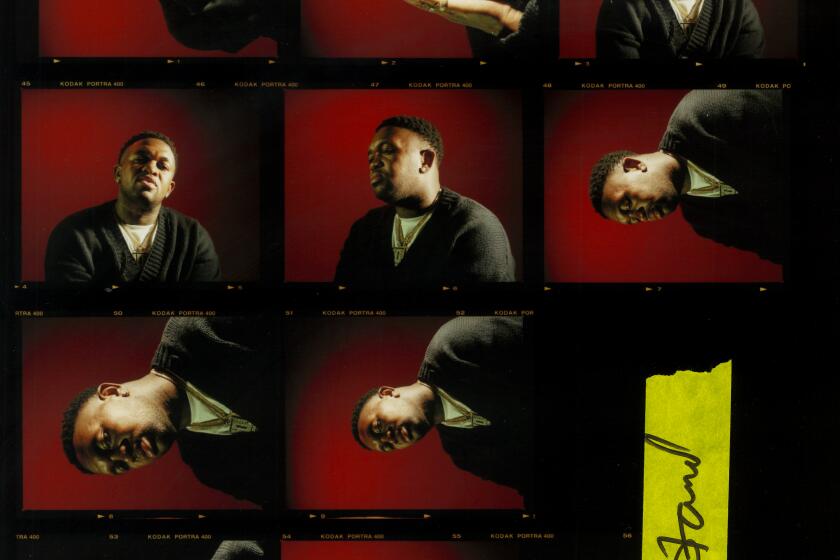For Kendrick Lamar, spite is an engine on the exhilarating ‘GNX’

- Share via
Kendrick Lamar starts his exhilarating new album by complaining that someone vandalized a mural depicting his face — a mural depicting his face in triplicate, in fact — on the side of a Honduran restaurant in his Compton hometown. Never mind that somebody cared enough about Lamar to paint the mural in the first place. What the 37-year-old rapper is pissed about is that this billboard-sized monument to his greatness was defaced.
That’s the energy Lamar is tapped into on the deeply irritated “GNX,” which came out by surprise Friday morning, eight months to the day after he jumped into an epic feud with Drake that ended up lifting Lamar to new heights of commercial success and cultural prestige. (That the Pulitzer Prize winner vanquished Drake in their beef now goes without saying.) In April, he scored a No. 1 single with his appearance on Future and Metro Boomin’s “Like That”; in May, he did it again with his own “Not Like Us.” Lamar put on a historic all-star concert in June at Inglewood’s Kia Forum, then announced that he’ll headline the Super Bowl halftime show in New Orleans in February, just a week after “Not Like Us” is set to compete for record of the year and song of the year at the 67th Grammy Awards.

Yet grievances abound on “GNX,” whose dozen tracks had taken spots 1 through 12 on Spotify’s U.S. Top 50 by early Sunday and which is all but certain to debut atop the Billboard 200 next week with one of 2024’s biggest openings. In “Wacced Out Murals” he can’t believe that Snoop Dogg had the audacity to post one of Drake’s diss tracks on social media — “I prayed it was the edibles” is his concern-trolling explanation — and laments Lil Wayne’s public disappointment that Lamar got the Super Bowl gig instead of him. “Used to bump ‘Tha Carter III,’ held my Rollie chain proud,” he raps, “Irony, I think my hard work let Lil Wayne down.”
“Hey Now” is about the punishing scrutiny he faces as a celebrity, while “Peekaboo” questions those trying to tarnish his legacy. “I did it with integrity and n— still try hate on me,” he growls in “Man at the Garden” — a distinct shift in outlook from Lamar’s previous album, 2022’s knotty “Mr. Morale & the Big Steppers,” where he was riven by self-doubt after a decade of being held up as the voice of his generation. Here, in contrast, he’s daring anyone to say he doesn’t deserve to be admired (even if few beyond Drake have actually suggested that he doesn’t).
The L.A. producer’s moment in hip-hop has been a lifetime in the making. He explains how his grind in the world of West Coast rap prepared him for the runaway success of Kendrick Lamar’s smash “Not Like Us.”
Whatever its source at this point, indignation remains a valuable motivator of Lamar’s art; his writing and rapping on “GNX” are as razor-sharp as they were in the brutal diss tracks he released one after another, Drake barely getting a second to breathe between them, this past spring. As funny too: “N— feel like he entitled ’cause he knew me since a kid,” he sneers in “TV Off,” “Bitch, I cut my granny off if she don’t see it how I see it.” Lamar is worked up about liars, about folks doling out backhanded compliments, about other rappers with “old-ass flows” wasting space with empty rhymes. Indeed, what seems to make him angriest is the idea that a person could triumph in hip-hop by taking hip-hop less seriously than he does. The album closes with a song called “Gloria” in which he spends nearly five minutes extending a detailed metaphor that positions writing as the great love of his life.
As eager as he is to frame himself as a singular talent, Lamar happily shares the spotlight on “GNX,” passing the mic to a number of young L.A. up-and-comers including Dody6, Lefty Gunplay, Wallie the Sensei and AzChike; in the title track, he doesn’t even take a verse, merely joining Hitta J3, YoungThreat and Peysoh on the song’s chorus. “Heart Pt. 6” recounts his origin story as a member of L.A.’s scrappy yet shrewd Top Dawg crew. And then there’s the lithe and funky “Dodger Blue,” in which he’s but a humble product of the oft-misunderstood city that shaped him: “Don’t say you hate L.A. when you don’t travel past the 10,” goes one line destined to be seen on a T-shirt or hoodie any day now.

Produced by a team led by Lamar’s longtime collaborator Sounwave and the pop hitmaker Jack Antonoff — Mustard, who helmed “Not Like Us,” also co-produced two tracks — “GNX” is steeped in West Coast styles and sounds; the music slaps, slides, bounces and shimmies. Several songs ride highly recognizable samples: In “Reincarnated,” a densely lyrical fantasy in which Lamar imagines his past lives, the beat is “Made N—” by 2Pac, the late philosopher-braggart in whose contradictions Lamar has always found inspiration; “Luther,” a sensual duet with SZA, remakes Luther Vandross and Cheryl Lynn’s remake of “If This World Were Mine” by Marvin Gaye and Tammi Terrell — a gorgeous piece of lineage-making that calls to mind Beyoncé’s archival ambitions on albums like “Renaissance” and “Cowboy Carter.”
Even amid those plush textures, though, Lamar has retribution on his mind. “If this world was mine, I’d take your enemies in front of God,” he promises-slash-threatens, “Introduce them to that light, hit them strictly with that fire.” Watch out.
More to Read
The biggest entertainment stories
Get our big stories about Hollywood, film, television, music, arts, culture and more right in your inbox as soon as they publish.
You may occasionally receive promotional content from the Los Angeles Times.










